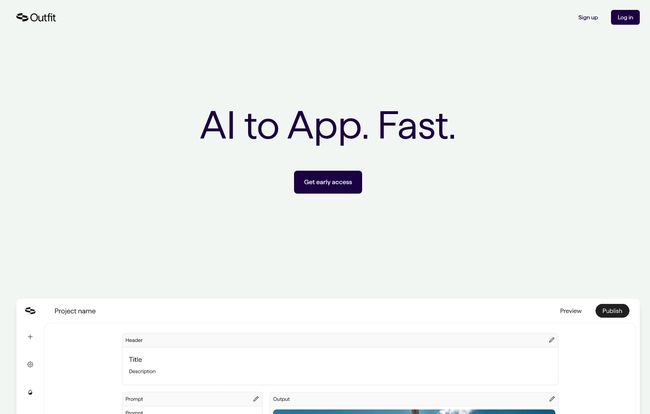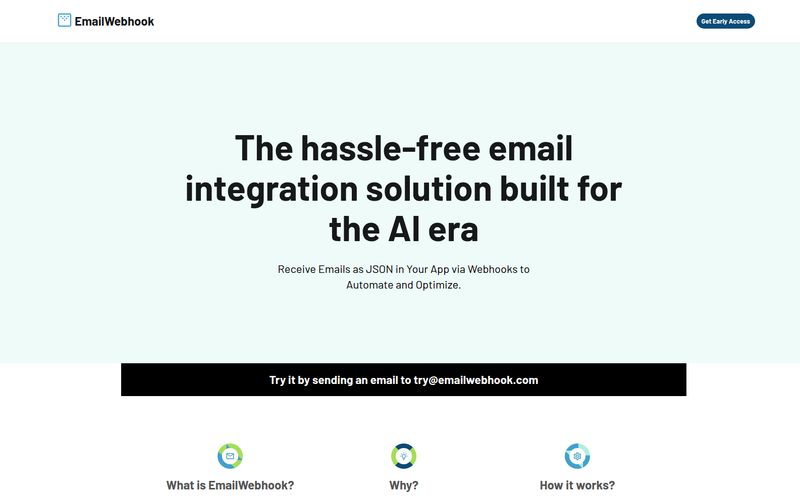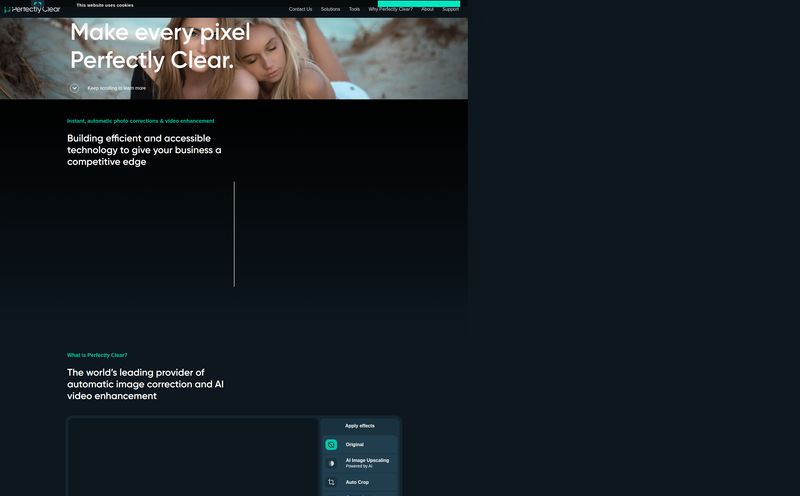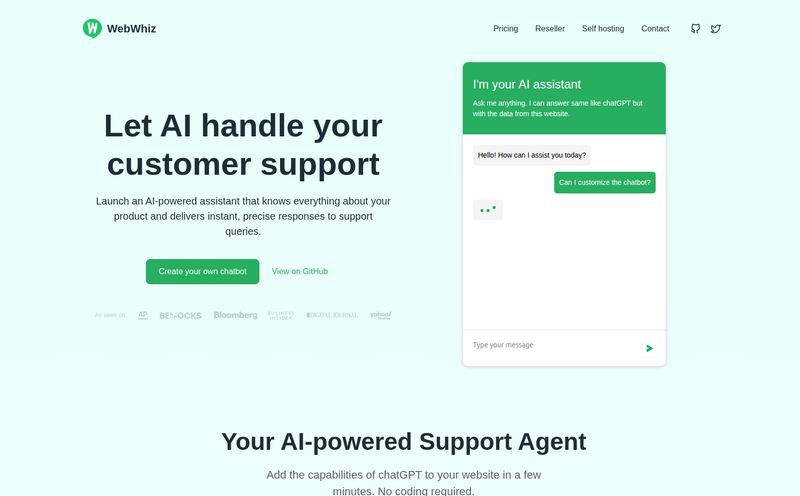I spend a lot of my time neck-deep in the world of AI. It’s a wild place. On one hand, you have these ridiculously powerful models from OpenAI, Anthropic, Midjourney... you name it. They can write poetry, debug code, or paint a picture of a frog in a tuxedo. It's magic. But on the other hand, getting that magic into the hands of an actual, regular person? That’s another story entirely.
It often feels like we’re standing on opposite sides of a canyon. Over there, the raw, untamed power of AI. Over here, the end-user who just wants a simple button to press. For years, the bridge between those two sides has been built with lines and lines of code, server configurations, and a whole lot of technical headaches.
Then, the other day, I stumbled across a new tool called Outfit. Their headline grabbed me immediately:
AI to App. Fast.
Okay, you have my attention. Could this be the pre-fabricated, easy-to-assemble bridge we've been looking for? Let's take a look.
So What Exactly is Outfit?
From what I can gather, Outfit is a no-code design tool made specifically for creating custom interfaces for AI applications. Think of it like this: your AI model (maybe it’s a GPT-4 prompt chain or a custom Stable Diffusion model) is the powerful, complicated engine of a supercar. It’s a masterpiece of engineering, but it’s not exactly something you can just hop into and drive.
Outfit aims to be the tool that lets you build the beautiful, user-friendly dashboard for that engine. The polished steering wheel, the comfy leather seats, the big friendly “GO” button. All without needing to be a master mechanic (or in this case, a full-stack developer). It’s a drag-and-drop environment where you can build a front-end, decide what controls your users see, and then publish it as a working app.

Visit Outfit
The Promise of No-Code AI Front-Ends
Let's be real, the no-code movement has already transformed web design with platforms like Webflow and Bubble. But the AI space has been lagging. We have things like Hugging Face Spaces and Streamlit, which are fantastic for data scientists and engineers who want to quickly demo a model. I use them myself. But they often have a distinctly… technical feel. They're built by engineers, for engineers.
The idea of a tool that prioritizes the UI/UX first is a game-changer. It solves what I call the "last mile" problem of AI. You’ve done the hard work of training or fine-tuning a model, but the final step—making it presentable and usable—is often a huge hurdle. If Outfit can deliver on its promise, it could empower a whole new wave of creators to build and launch AI-powered micro-SaaS products, internal tools, and neat little experiments.
A Closer Look at Outfit's Features (Based on What We Know)
Since Outfit is currently in an "early access" phase, we're working off their landing page. But it gives us some juicy details to chew on.
The All-Important Drag-and-Drop Canvas
The screenshot they show is the heart of it all. It looks clean, almost like Canva or Figma. You can see elements for a title, a description, a prompt input box, an image uploader, and an output display. You literally drag these components onto the canvas to build your app's interface. This is the core of its accessibility. No wrestling with CSS or Javascript frameworks. Just you, your mouse, and your idea.
"Integrate with Any Model" - The Holy Grail?
This is a bold claim. Any model? My guess is this works by connecting to models via their APIs. You'd likely provide an API key for, say, OpenAI, and then wire up the inputs on your Outfit canvas to the parameters of the API call. If they can make this process truly simple and universal, it's incredibly powerful. It means you aren't locked into one ecosystem. You could have a text input powered by Anthropic's Claude and an image input powered by Stability AI, all in the same interface. Its a pretty exciting prospect.
Full Control Over the User Experience
This is what separates a tool like Outfit from a more basic demo platform. It’s not just about making it work; it’s about making it look and feel the way you want. You get to control the layout, the branding, and what settings the user can actually mess with. Want to fix the 'temperature' setting on your language model to 0.7 and not let the user change it? You can hide that. Want to brand the entire app with your company’s colors and logo? That seems to be the whole point.
One-Click Deployments
Anyone who's ever tried to deploy a web app knows the pain. DNS settings, server provisioning, build processes... it can be a nightmare. Outfit promises one-click deployment. You design your app, you hit "Publish," and it's live on the web. For indie hackers and fast-moving teams, this speed is worth its weight in gold. It means going from idea to live, shareable app in minutes, not days.
The Elephant in the Room: The Cons and Unknowns
Okay, let's ground ourselves for a second. While I'm optimistic, there are a few things to consider. The site itself lists a potential con: "May require design skills to create appealing interfaces." And that's fair. A tool can make things easy, but it can't give you good taste. A drag-and-drop builder in the wrong hands can still lead to some... questionable designs. You've seen those MySpace pages, right?
More importantly, there's a lot we don't know. I went looking for a pricing page, a features list, some documentation. And... well, I found a 404 error page.
Honestly, I don't even see this as a huge negative. It just confirms what the "Get early access" button tells us: this thing is new. They're likely still figuring out the finer details and pricing structure. It adds a bit of mystique, a feeling of getting in on the ground floor before everyone else knows about it.
Who Is Outfit Actually For?
As I think about it, I can see a few people getting really excited about this:
- The Indie Hacker: Someone with a great idea for a niche AI tool (like a 'Slogan Generator for Plumbers') who can code a bit of Python but doesn't want to build a whole front-end from scratch.
- The Marketing Team: They want to create an internal tool for their team to generate social media posts using a specific prompt structure, branded with company colors.
- The AI Researcher: A PhD student who's built an amazing new model for analyzing sentiment but needs a simple, elegant way to let others test it without needing to run a Jupyter notebook.
- The Agency: A creative agency that wants to quickly build and deploy custom-branded AI apps for their clients as part of a campaign.
A Quick Comparison
To put it in perspective, here’s how Outfit (in theory) stacks up against other methods:
| Method | Ease of Use | Customization | Deployment Speed | Technical Skill Needed |
|---|---|---|---|---|
| Outfit.so (Promised) | Very High | High (Visual) | Instant | Low |
| Custom Code (Flask/React) | Very Low | Total | Slow | Very High |
| Hugging Face Spaces | Medium | Medium (Code-based) | Fast | Medium (Python) |
Final Thoughts - Is It Worth Getting Early Access?
In my opinion? Absolutely. Signing up for early access is a no-brainer. The potential here is huge. We are desperately in need of tools that democratize access not just to using AI, but to building with AI. Outfit appears to be tackling a genuine, painful problem in the creator and developer space.
It’s not about replacing developers. It’s about empowering a different kind of builder—the designer, the marketer, the subject-matter expert—to bring their own AI-powered ideas to life. I’m genuinely excited to see where this goes. I’ve already put my name on the early access list, and I'll be sure to report back once I get my hands on it. For now, it’s a promising sign of a future where building an AI app is as easy as designing a slide deck.
Frequently Asked Questions About Outfit
What is Outfit?
Outfit is a no-code, drag-and-drop tool for designing, building, and deploying custom user interfaces for AI applications. It lets you create a user-friendly front-end for any AI model or workflow without writing code.
Do I need to know how to code to use Outfit?
No. The entire premise of Outfit is that it's a "no-code" platform. The interface is built using a visual drag-and-drop editor, similar to a website builder.
What kind of AI models can I use with Outfit?
Outfit claims you can "integrate with any model." This likely means any model that has an accessible API, such as those from OpenAI, Anthropic, Stability AI, or custom models you host yourself.
How much does Outfit cost?
As of now, pricing information for Outfit is not publicly available. The tool is in an "early access" phase, and pricing details will likely be released closer to a full public launch.
Is Outfit a replacement for website builders like Webflow?
Not exactly. While it shares the drag-and-drop concept, Outfit is highly specialized for creating interfaces for AI apps, focusing on inputs (prompts, images) and outputs. Webflow is a more general-purpose tool for building complete, multi-page websites.
How do I get access to Outfit?
You can visit their official website, outfit.so, and sign up for the early access list. This will put you in line to get an invitation to use the platform.
Reference and Sources
- Official Website: Outfit.so
- No-Code Movement Overview: The No-Code Revolution (Forbes)



